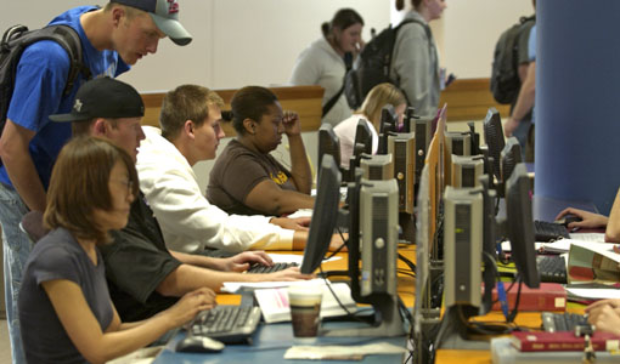A welcome poster in the front window of O'Shaughnessy-Frey Library Center has an image from one of the original library's small stained glass medallion windows. The image is of Sherlock Holmes, to which has been added the tagline, "Where the Search Begins."
This image, a creation of the 1950s, with a character from the 19th century, roots the St. Thomas libraries in the tradition of books and research. At the same time, we are growing into something new.
We are seeing large increases in the numbers of students using our libraries (in some months, over 100 percent increase from the previous year.) There is a level of activity and energy that had been missing for many years. It all has to do with a new kind of academic library.
In fall 2004, the possibility of a viable digital library moved toward reality. On Dec. 3, the Chronicle of Higher Education reported on Google's launch of the new search tool Google Scholar that reportedly "could make libraries obsolete ... ." On Dec. 10, the Chronicle carried an opinion essay with the title "College Libraries: The Long Goodbye":
So turn off your computer and take a stroll down to the campus library. Walk through the stacks and begin saying your goodbyes to the shelves of printed books. It may not be this year, this decade, or even before you retire - but drastic changes in the ways libraries and scholarly publishers operate are coming, and their effects will extend throughout the academy.
Beginning a transformation
Rather than saying goodbye, St. Thomas is working to create a graceful transition to a new idea of the library - one that supports both scholarship and community.
The St. Thomas libraries laid the foundation for a transformation with an Information Commons, first in the Minne-apolis campus' Keffer Library and then in the St. Paul campus' O'Shaughnessy-Frey in the summer of 2004. Now the Info-commons - a program rather than one physical place - integrates several academic support functions and unites the academic library with the associated services that support learning on campus. It brings together the university's print collections, research and reference services, computers, support for student productivity tools, faculty technology development support, and support for media and multimedia applications.
Based on the notion of a space that exists for the community good, the Infocommons creates - in physical space and on the Web - scholarly services to students and faculty, supporting research from contemplation and discovery through the research and evaluation and writing process.
While the libraries always have provided the support that students need as they conduct initial research, we have not typically provided help with the final stages of writing, creating presentations or other projects. Further, new models of scholarship, which use digital technologies for research, analysis, communications and teaching, have created a need for partnerships among scholars, librarians, Web developers and information technology professionals - all collaborations that the Infocommons facilitates.
The Infocommons - An assessment
The Infocommons is the centerpiece for the use of technology and information resources and a meeting place for the exchange of ideas and information in the digital age, just as the village commons was a social and intellectual gathering place for earlier generations. The move toward the Infocommons is having a real impact.
But now that we attract more students to the libraries, are we engaging them? Are they using our services in greatly increased numbers? Are they checking out more books? Are the libraries and their Infocommons making a difference in student learning and scholarship? What is our responsibility as a modern academic library? How should we best allocate our resources and organize our staff as we set our direction for the future?
To answer these questions, we conducted an assessment in the spring of 2005, focusing on the changing expectations of students and faculty, as well as trends in the development of the libraries' collections. We conducted surveys and focus groups with students and faculty, and analyzed data that has been collected for years on library use and collection building.
The results will help us set our future goals. We also want to raise awareness of current academic library issues. These findings will help us understand the implications of changes as we seek to become, in the words of our vision statement, "the intellectual and technological crossroads of information resources, teaching, and learning at UST."
"Best place to study on campus"
The development of the Infocommons quickly brought changes. We designed new furniture for O'Shaughnessy-Frey to accommodate more than 100 new public access computers. We gathered comments from student users, some of whom were confused initially by the changes in the array of services provided and in the expectations for behavior. In the Infocommons, for example, a reasonable level of noise and talking was permitted. Some were surprised by the appearance of the furniture (which is more colorful than traditional library furniture).
But the changes proved to be popular and the Dec. 10, 2004, Aquin, the student newspaper, identified O'Shaughnessy-Frey as the "Best Place to Study" on campus. One noted characteristic of the Infocommons was that "everything is in one spot" - referring to one of the key benefits of the library research as well as technical issues.
During the 2004-2005 school year, O'Shaughnessy-Frey experienced a very large increase in the number of users. For example, in April 2005, we had 67,000 visitors - a 110 percent increase over the previous April.
We extended O'Shaughnessy-Frey's closing time to 2 a.m. on most nights, in response to repeated requests by students for longer hours. During the semester, an average of 70 students were still using the library at midnight and 33 at 1 a.m. - and those numbers increased dramatically during finals week. Students sponsored study breaks with lemonade and cookies to promote the new hours, a popular practice that continued through 2005-2006.
Students need a neutral place on campus where they can study - an academic space where they can research, write papers, consult with each other in group settings, and meet and work with faculty. (If the place has good coffee, so much the better.)
Fears that digital content will kill the library as an important physical space have been laid to rest by our experience. We see a level of energy and activity in the libraries not experienced for years. We also hope that a library can build community. It can be a place for both solitary and social work, for reading and group study, for scholarship and friendship.
Information literacy
It was also clear that student research behavior has changed. Among undergraduate students, 80 percent turn to electronic sources of information first (both library-purchased content and the free World Wide Web). Among graduate students, 93 percent reported they got most of their information from electronic sources, results consistent with national findings. A 2004 report from the Pew Internet and American Life project found that 90 percent of American adults have used search engines, 63 percent of them on a daily basis. According to Pew, the vast majority (87 percent) say they have "successful search experiences most of the time."
A principal goal of our libraries is providing instruction in the wise use of electronic information in a technology-rich environment. Librarians conduct more than 500 instructional sessions each year, most arranged in collaboration with faculty and designed to enhance student research skills.
While there is a high level of satisfaction with these instructional services, several faculty were troubled by student research habits. Faculty are aware of the seductive nature of the Web as a source of information. One teacher said, "I find my-self doing what I criticize my students for - using only my computer for research."
Of course, it may be true that students are not sure what librarians do. One student when asked about the role of the librarians in an academic library replied, "I thought you were there to watch us."
Our challenge is to engage and train students in information literacy - the effective use of information for scholarship and for daily life. While we attract large numbers of users, we can do a better job of engaging them to take full advantage of our services and collections. Several comments from students and faculty suggest that there may not be enough clarity around the expectations of students to conduct research, and what constitutes good quality student scholarship.
Collections
The possibilities for a digital future for libraries' collections are real. Our libraries are developing collections with the appropriate mix of print and electronic, books and journals. Overall, the St. Thomas libraries have 615,000 volumes, seating for 2,630 and digital resources that include CLICnet, the shared catalog of the collections of the Twin Cities' private college libraries, 150 electronic databases covering all academic disciplines, access to nearly 30,000 electronic journals and 8,000 electronic books.
Continual monitoring of the use of our resources will help us maintain this balance. In the past 10 years we have seen large increases in spending on electronic resources (316 percent increase) while our budget for print increased by only 6 percent in the same period, as these comparisons between 2002 and 2006 illustrate:
· The total library budget for information resources in 2006 is $1,384,000 (2002: $1,134,000);
· Print (books and journals) in 2006 is $716,000 (2002: $861,000);
· Electronic material in 2006 is $668,000 (2002: $273,000);
· Total number of active print journal subscriptions in 2006 is 1,219 (2001: 2,664).
In our journal collection, the shift from print to electronic continues - in fiscal 2003, we spent 71 percent of our budget on print and 29 percent on electronic. This year, that ratio was 47 percent print and 53 percent electronic. Annual price increases of more than 10 percent in journal subscriptions put tremendous pressure on the libraries' book budget, which led us to reductions in the journal collection. We managed with the advice of faculty to often replace a print subscription with an electronic equivalent. The use of print journals has declined dramatically.
The main objective for our collection and management efforts - and our challenge - is to identify areas of the collection that need to be strengthened, allocate budget wisely between print and electronic resources, and ensure that each academic department has the resources it needs to support the curricular goals.
Future directions
We began our assessment by trying to describe our responsibility as the academic libraries serving St. Thomas. In the end, we've identified objectives that focus on three major roles:
· The library as place - supporting learning and nurturing community. Specific possibilities include redesign of the services desks, development of a "faculty technology and teaching" center, and the installation of a coffee shop.
· The library as instructor - collaborating with faculty to enhance scholarship.
· The library as content manager - managing collections (print and digital) in multiple formats to meet needs of today and tomorrow.
As the libraries look to the future, we are excited by the opportunity to create the academic library of the 21st century - an energetic and vital library that continues to stand at the center of the academic enterprise as it has for centuries.
Librarians stress the best research practices
• Use peer-reviewed articles whether they are in electronic format or in print.
• Identify "classic" books and articles (by reading bibliographies carefully to see what has been cited most frequently).
• Distinguish between free information on the Web and library-subscribed data-bases.
• Resources in library-subscribed databases tend to be more reliable; authors have credibility; books and articles are peer reviewed.
• Free information on the Web must be evaluated especially carefully - anyone can put anything on the Web.• Evaluate all resources for accuracy, authority, objectivity, currency, coverage and relevancy.
• Understand social, legal and ethical issues related to research and writing (for example, copyright and plagiarism).





